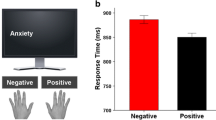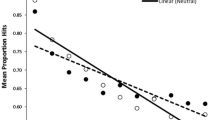Abstract
The effect of irrelevant emotional and neutral stimuli on the performance of a color-naming task is examined with two groups of subjects: pilots and bus drivers. It is found that (1) the emotional stimuli disrupt performance in both groups, (2) the decrement in performance is relatively larger in the pilot group, and (3) the effect of the emotional stimuli appears to persist over time.
Similar content being viewed by others
References
Agnew, N., & Agnew, M. (1963). Drive level effects on tasks of narrow and broad attention.Quarterly Journal of Experimental Psychology, 15, 58–62.
Barber, P.J., & de la Mahotiere, C. (1982). Perceptual defence: Attempted replication using the dark adaptation paradigm.Canadian Journal of Psychology, 36, 94–104.
Broadbent, D.E. (1979). Is a fatigue test now possible?Ergonomics, 22, 1277–1290.
Broadbent, D.E., & Gregory, M. (1967). Perception of emotionally toned words.Nature, 215, 581–584.
Easterbrook, J.A. (1959). The effect of emotion on cue utilization and the organization of behavior.Psychological Review, 66, 183–201.
Horowitz, M.J. (1979). Psychological response to serious life events. In V. Hamilton & D.M. Warburton (Eds.),Human Stress and Cognition Chichester: Wiley.
Jennings, L.B., & George, S.G. (1975). Perceptual vigilance and defense revisited: Evidence against Blum’s psychoanalytic theory of subliminal perception.Perceptual and Motor Skills, 41, 723–729.
Liebert, R.M., & Morris, L.W. (1967). Cognitive and emotional components of test anxiety: A distinction and some initial data.Psychological Reports, 20, 975–978.
Morris, L.W., Davis, M.A., & Hutchings, C.H. (1981). Cognitive and emotional components of anxiety: Literature review and a revised Worry-Emotionality Scale.Journal of Educational Pychology, 73, 541–555.
Nielsen, S.L., & Sarason, I.G. (1981). Emotion, personality and selective attention.Journal of Personality and Social Psychology, 41, 945–960.
Pallak, M.S., Pittman, T.S., Heller, J.F., & Munson, P. (1975). The effect of arousal on Stroop color-word task performance.Bulletin of the Psychonomic Society, 6, 248–250.
Sarason, I.G. (1980). Life stress, self-preoccupation, and social supports. In I.G. Sarason & C.D. Spielberger (Eds.),Stress and Anxiety (Vol. 7) Washington, DC: Hemisphere.
Tecce, J.J., & Happ, S. (1964). Effects of shock-arousal on a card-sorting test of color-word interference.Perceptual and Motor Skills, 19, 905–906.
Watts, F.N., McKenna, F.P., Sharrock, R., & Trezise, L. (in press). Colour-naming of phobia-related words.British Journal of Psychology.
Wine, J. (1971) Test anxiety and direction of attention.Psychological Bulletin, 76, 92–104.
Wine, J.D. (1980). Cognitive-attentional theory of test anxiety. In I.G. Sarason (Ed.),Test anxiety: Theory, research and applications Hillsdale, N.J.: Erlbaum.
Author information
Authors and Affiliations
Rights and permissions
About this article
Cite this article
McKenna, F.P. Effects of unattended emotional stimuli on color-naming performance. Current Psychology 5, 3–9 (1986). https://doi.org/10.1007/BF02686591
Accepted:
Published:
Issue Date:
DOI: https://doi.org/10.1007/BF02686591




